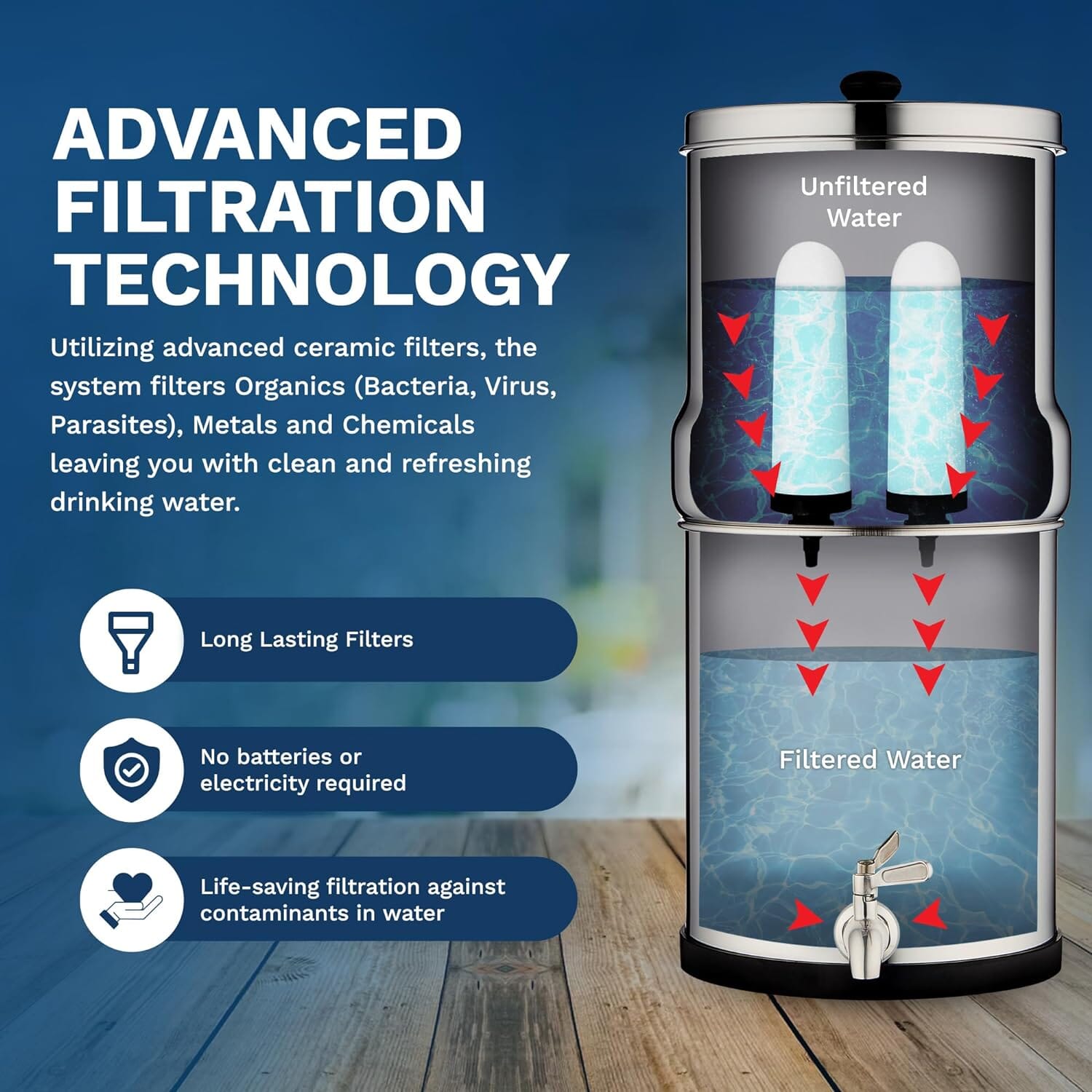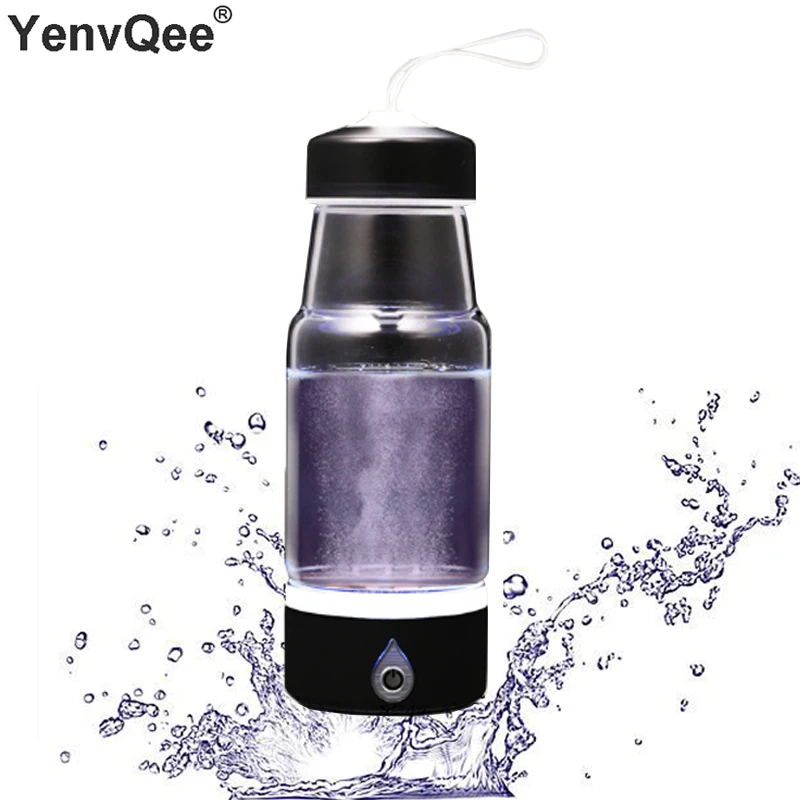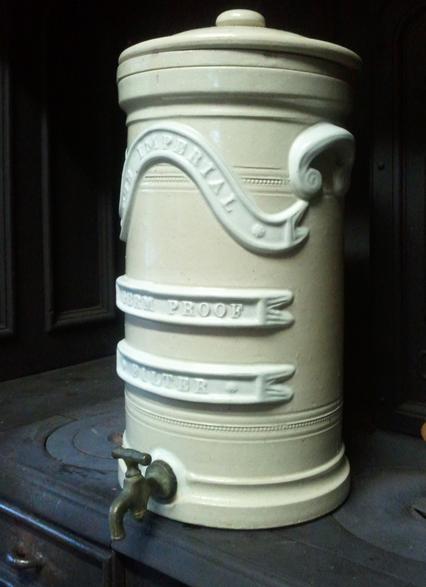Secrets in the Pores: How Ceramic Filters Trap Contaminants
At the heart of every ceramic filter lies a network of microscopic tunnels—each just 0.2 to 0.5 microns wide—that physically block bacteria, protozoa, and sediment as water squeezes through. These pores are so small that even E. coli can’t slip past, removing over 99% of common pathogens before they reach your glass [1] and guiding water along a twisting, labyrinthine path deeper into the ceramic matrix [2]. But it isn’t just a passive sieve. After firing, many filters are coated in colloidal silver, which halts bacterial growth on the surface and within those tortuous channels, extending the life of each element.
Research shows this dual action—physical straining plus antimicrobial silver—can boost microbe removal efficiency by up to 15% compared to uncoated ceramics [4]. Designs like the TerraClear pot use the same principle, nesting a ceramic candle in a tank that stays clean even in dusty environments [5]. I still remember the relief when muddy well water transformed into crystal-clear drinking water through my first ceramic candle filter—it felt like magic. In homes and camps worldwide, these simple yet powerful devices serve as silent guardians, offering a sustainable and chemical-free way to enjoy fresh water. Learn more about bringing this low-tech marvel into your own kitchen with our ceramic filtration system.

From Pottery Wheels to Water Purifiers: The Fascinating History of Ceramic Filtration
The tiny pores in an ancient clay pot paved the path for clean water that millions rely on today.
Long before plastics and cartridges, people discovered that shaped clay could trap dirt and germs while letting water flow through—a practice dating back over 4,000 years in Mesopotamia and Egypt [3]. Archaeologists have unearthed simple clay pitchers with porous walls that acted as early strainers, hinting at humanity’s first steps toward safer drinking water [4].
Fast forward to Victorian London, where John Doulton turned this humble idea into an industrial reality by firing fine clay into candle-shaped cartridges that could remove bacteria and sediment on a large scale [1]. I love imagining families in the 1800s filling earthenware pots, then watching as clear water dripped through microscopic pores—a simple miracle that cut typhoid cases dramatically. Today, you’ll even find durable whole-house ceramic filters and compact units blending ancient clay techniques with contemporary engineering to serve remote communities without power.

What Stays and What Goes: Exploring the Contaminant Removal Spectrum
Just a porous clay shell can stand between you and waterborne illness, turning murky streams into safe, clear drinking water.
Ceramic filters rely on microscopic pores—around 0.2 to 0.5 microns—to physically strain out over 99% of bacteria and protozoa like Giardia and Cryptosporidium, while also trapping fine sediment that clouds water [1][5]. The result? Crystal-clear water that tastes fresher and feels safer, just by gravity and the magic of tiny pores operating like a natural aquifer in your kitchen.
I’ve seen families in rural villages celebrate when their simple filters reduced cloudy turbidity to glass-like clarity in minutes, making chores and cooking a joy again. The ceramic’s silver impregnation also slows microbial growth, giving extra peace of mind during long dry seasons [2]. Yet, not everything stays behind these clay walls: viruses, often smaller than 0.1 microns, slip through the pores unless paired with UV or chemical treatment. Dissolved chemicals—like heavy metals and pesticides—also pass right on, demanding an extra layer such as activated carbon or a reverse osmosis stage for true chemical-free confidence.
Handmade vs. High-Tech: Crafting Your Own Ceramic Filter At Home
Traditional artisans mix clay with sawdust or rice husks, shape it into a simple cartridge, and fire it in a backyard kiln—creating pores around 0.2–0.5 microns that trap bacteria and sediment just like nature’s aquifers [1][2]. One relief worker recalls, “I remember scrubbing that rough surface, then tasting the clean water—like magic in a mug.”
On the flip side, modern workshops use slip casting or even 3D printing to control pore size and shape with laser-like precision. Cartridges are coated in colloidal silver to cut microbial growth and can flow up to 3.5 L/hour in a gravity-fed unit [5]. Engineers report bacterial removal rates above 99.9%, and computer models predict uniform flow even under heavy use, though the initial equipment investment can top several hundred dollars.
Choosing between the two often comes down to heart versus horsepower: handmade filters cost just a few dollars in local clay and fuel, offering a hands-on lesson in sustainability, while high-tech cartridges deliver consistent performance and faster output. Whether I’m shaping clay by hand or watching a 3D printer hum, there’s something deeply satisfying about turning mud into medicine.
Pore Size Matters: Decoding the Science Of Filtration Efficiency
Tiny as they are, the pores in a ceramic filter hold the power to block invisible dangers and deliver water so pure it feels like a fresh mountain spring.
At the heart of every ceramic filter lies a network of microscopic openings—usually between 0.2 and 0.5 microns—that act like a super-fine sieve, physically stopping bacteria, protozoa, and sediment in their tracks [1][2]. These tiny gaps are smaller than most bacteria, so when water squeezes through the ceramic walls, harmful microbes can’t escape.
| Pore Size Range (µm) | Contaminant | Removal Efficacy |
|---|---|---|
| 0.2–0.5 | Bacteria (E. coli) | >99.9% |
| 0.2–0.5 | Protozoa (Giardia) | >99.9% |
| <0.1 | Viruses (Hepatitis A) | Not removed |
| 5–20 | Sediment | >95% |
When Your Filter Clogs: Tips for Cleaning and Long-Term Care
That moment when your ceramic filter’s drip slows to a trickle can feel like a doomsday—yet the cure is often in your hands.
Over weeks of use, tiny pores become packed with sediment and biofilm, cutting your flow rate in half and leaving you staring at an empty glass [3]. Rather than panic, grab a soft brush and hold the ceramic element under cool, running water to gently scrub away trapped debris. Studies show that a simple cleaning can restore up to 90% of original flow, giving you nearly new performance without buying a replacement [4].
For best results, remove the filter from its housing and use a nonabrasive brush—never harsh chemicals—to avoid stripping the silver coating that fights microbial growth [5]. “I couldn’t believe how a quick scrub had my filter working like new,” says homeowner Lisa M., who credits monthly maintenance with saving hundreds on replacements. If you’re running a whole-house system, cleaning both the sediment and ceramic elements together keeps your entire setup humming.

Minerals Retained, Toxins Rejected: Health Impacts of Ceramic Filtration
Every pour through a ceramic filter feels like nature gently keeping the good stuff and washing away the bad.
Ceramic filtration naturally holds onto beneficial minerals like calcium and magnesium, giving your water a crisp, refreshing taste while supporting healthy bones and muscle function—up to 95% of these essential electrolytes pass right through the 0.2–0.5-micron pores intact [4]. By mimicking underground aquifers, the porous clay matrix preserves heart-healthy minerals that often get stripped away by high-pressure systems [1].
At the same time, those microscopic channels block over 99% of bacteria and protozoa, and when the ceramic is treated with colloidal silver or combined with activated carbon, heavy metals like lead and mercury are captured too [2][5]. Local projects in rural areas report dramatic drops in waterborne illness after switching to these filters, with families celebrating clearer, safer water without chemical additives [3].
A Planet-Friendly Choice: Environmental Advantages Of Ceramic Filters
Ceramic filters require no electricity, chemicals, or disposable parts, instantly cutting carbon footprints by up to 90% compared to electric systems [4]. Their gravity-fed design mimics nature’s own filtration, letting water gently percolate through microscopic pores and silver-treated surfaces—just like underground aquifers letting only pure H₂O pass.
Most models are crafted from a blend of clay and combustible organic material like rice husks or sawdust, shaped and fired in small kilns that can run on scrap wood. This low-tech manufacturing demands far less energy than plastic or stainless steel filters, and it can be done by local artisans using simple tools [5].
On average, a single ceramic cartridge can filter over 10,000 liters of water—avoiding the production of roughly 2,000 plastic bottles in its lifespan [1]. I still remember my first filter, the joy of sipping crystal-clear water while knowing I’d just spared a mountain of plastic from landfills.
Tomorrow’s Filters Today: Cutting-Edge Innovations in Ceramic Technology
Imagine sipping water so pristine that even the tiniest microbes can’t slip through—modern ceramic filters are making that a reality.
Recent breakthroughs in nano-infused ceramics have pushed filtration efficiency to new heights, with lab tests showing over 99.99% removal of bacteria and protozoa while boosting flow rates from 3.5 to 5 liters per hour thanks to graphene oxide enhancements [4]. These advanced materials create more uniform pore structures, cutting down clogging and extending filter life—an absolute game-changer for families relying on gravity-fed systems in remote areas.
Design innovations are just as exciting: some filters now feature a honeycomb architecture that maximizes surface area and integrates an activated-carbon interlayer to tackle dissolved chemicals and bad tastes [5]. Whether you’re outfitting a tiny cabin or upgrading your home system, these next-gen ceramic filters blend sustainability and performance.
Key Takeaways & Final Words
Ceramic water filters quietly save lives by combining simple clay designs with powerful impurity removal. At their core, they physically block over 99% of bacteria and protozoa through tiny pores, creating a reliable shield against waterborne illnesses [1][2][5]. Their non-electric, gravity-fed design means no power bills or fancy gadgets—just water moving through a maze of clay, trapping sediment and microbes with every drop.
Despite their strengths, ceramic filters struggle with the smallest threats: viruses can slip through pores smaller than 0.2 microns, and dissolved chemicals like heavy metals remain untouched without added media. Their flow rate—often just a few liters per hour—can feel like watching paint dry when you’re thirsty, so patience (and a backup pitcher) is key. Paired with activated carbon or modern systems like reverse osmosis, these filters become even more versatile. For families craving steady clean water, a full-scale whole-house ceramic filter or a compact ceramic filtration system delivers peace of mind—no power, no pump, just the reassuring drip of safety.
“`html
Complete Top Picks Comparison – 23 Products
| Product | Source | Price | Rating | Image | Buy |
|---|---|---|---|---|---|
| 【Upgraded】Renami Ceramic Filter Silver Infused Replacement for BB9-2® Black Activated Carbon Filters, Compatible with Berkey® Travel, Large, Royal, Crown Series, Repeatable Cleaning Filters, Pack of 2 | $39.99 | ★★★★☆ |  | Buy on Amazon | |
| 2 Pack 7” ceramic water filter Candle,7 inch water filter replacement filters with Activated Carbon for Countertop Gravity Water Filter System,Water Cooler Filtration Systems. | $31.05 | ★★★★☆ |  | Buy on Amazon | |
| Santevia Gravity Water System Filter | at Home Water Filter That Makes Water Alkaline and Adds Minerals | Chlorine and Fluoride Filter (Countertop Model) | $179.99 | ★★★★☆ |  | Buy on Amazon | |
| Purewell 2.25G Gravity Water Filter System with Water Level Window, 3-Stage Stainless Steel Countertop System with 2 Washable Ceramic Filters and Stand, Reduce up to 99% Chlorine, PW-KST | $169.00 | ★★★★☆ |  | Buy on Amazon | |
| AquaEasy 4 Inch Ceramic Water Filter Candles (Pack of 4) Replacement Filter for Gravity water filtration system | Household Water Bucket Filtration System | Suits all major brands | | $60.00 | ★★★★☆ |  | Buy on Amazon | |
| LifeStraw Home Water Pitcher, 7-Cup, White, Glass with Silicone Base, White, for Everyday Protection Against Bacteria, Parasites, Microplastics, Lead, Mercury, PFAS and a Variety of Chemicals | $64.99 | ★★★★☆ |  | Buy on Amazon | |
| Purewell 3-Stage Gravity Fed Water Filter System, 2.25 Gallon Stainless Steel Countertop System with 2 Washable Ceramic Filters, Metal Water Level Spigot and Stand, Reduce up to 99% Chlorine, PW-OBT-K | $0.00 | ★★★★☆ |  | Buy on Amazon | |
| 2 PCS 7 inch ceramic water filter Candle,7” water filter replacement filters with Activated Carbon for Countertop Gravity Water Filter System,Water Cooler Filtration Systems | $29.99 | ★★★☆☆ |  | Buy on Amazon | |
| Waterdrop Countertop Water Filter, NSF/ANSI 42&372 Certified,5-Stage Stainless Steel Faucet Water Filter for 8000 Gallons, Reduces Heavy Metals, Bad Odor and 99% Chlorine,WD-CTF-01(1 Filter Included) | $69.99 | ★★★★★ |  | Buy on Amazon | |
| Sawyer Products SP128 Mini Water Filtration System, Single, Blue | $28.99 | ★★★★★ |  | Buy on Amazon | |
| 420ML Portable Rich Hydrogen Generator Cup Water Filter Ionizer Pure H2 Hydrogen alkaline Bottle Electrolysis Drink Hydrogen | $26.63 | ★★★★★ |  | Buy on AliExpress | |
| Large Capacity Cold Water Jug Drink Dispenser Fridge Filter Design Spigot PP Sealed Cover Juices Beverages Container | $2.32 | ☆☆☆☆☆ |  | Buy on AliExpress | |
| ABKY-1L Water Filter Kettle With Activated Carbon Filtration System Drinking Water Purifier Jug | $22.86 | ☆☆☆☆☆ |  | Buy on AliExpress | |
| New For Brita Maxtra 2PCS/6PCS Water Filters Cartridge Limescale Chlorine Impurities Purify Kettle Activate Carbon Water Filter | $10.61 | ★★★★★ |  | Buy on AliExpress | |
| SOUDRON Household 13L 6 stages drinking mineral water filter purifier for water dispenser | $37.09 | ★★★★★ |  | Buy on AliExpress | |
| Large Water Pitcher With Scale 1.6L/2.2L Plastic Pitcher For Fridge Filter Ice Tea Kettle Juice Beverage Jar For Hot Cold Drinks | $3.64 | ☆☆☆☆☆ |  | Buy on AliExpress | |
| Tea Maker Wide Mouth Cold Brew Pitcher Beverage Container With Handle Leak Proof Infused Water Jar For Outdoor Studio Kitchen | $22.69 | ☆☆☆☆☆ |  | Buy on AliExpress | |
| Replace Refrigerator Water Filter For everydrop by whirpool filter 2, EDR2RXD1 For Element W10413645A WRF989SDAB | $17.74 | ★★★★★ |  | Buy on AliExpress | |
| DEYE 5KW 6KW On Grid Inverter SUN-5/6K-G05P1-EU-AM2 230VAC Single Phase 2 MPPT Low Start Up Voltage Of 80V Solar Charger | $170.58 | ☆☆☆☆☆ |  | Buy on AliExpress | |
| New Samsung DA29-00020B, DA29-00020A, HAF-CIN EXP advanced refrigerator water filter 1 pack | $19.54 | ☆☆☆☆☆ |  | Buy on AliExpress | |
| Waterdrop Chubby 10-Cup Water Filter Pitcher, NSF Certified,Long-Lasting 200 gal | $19.99 | ☆☆☆☆☆ |  | Buy on eBay | |
| Waterdrop 200-Gallon Long-Life Water Filter Pitcher, NSF Certified,7-Cup, White | $14.99 | ☆☆☆☆☆ |  | Buy on eBay | |
| Brita New Sealed Large 10-Cup Water Filter Pitcher With 2 Standard Filters | $32.99 | ☆☆☆☆☆ |  | Buy on eBay |
“`

